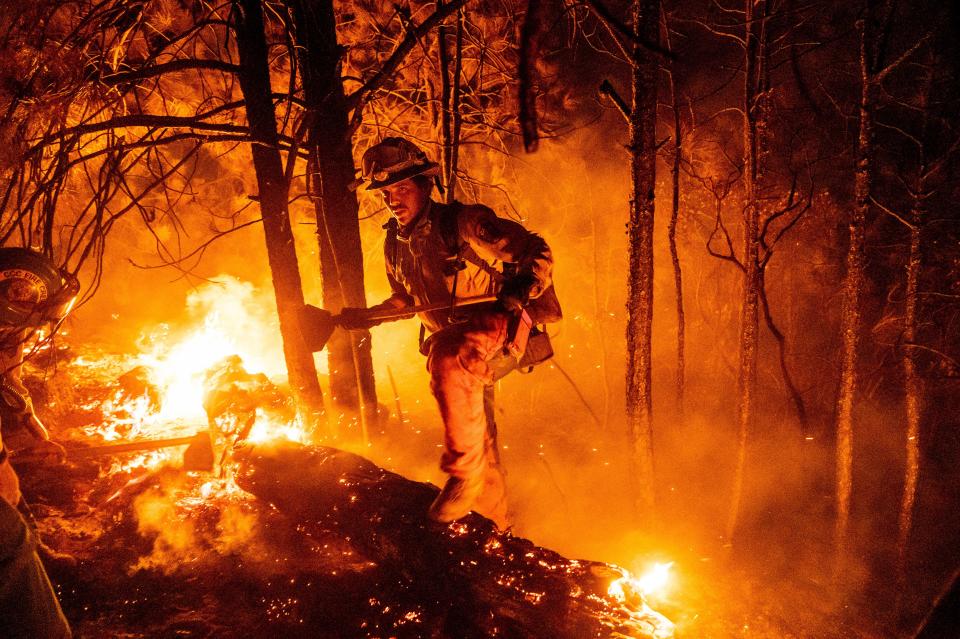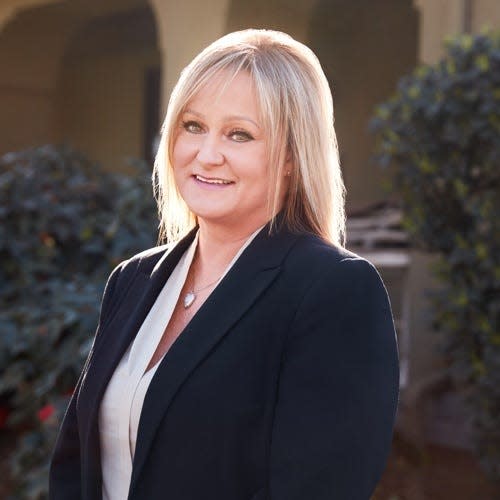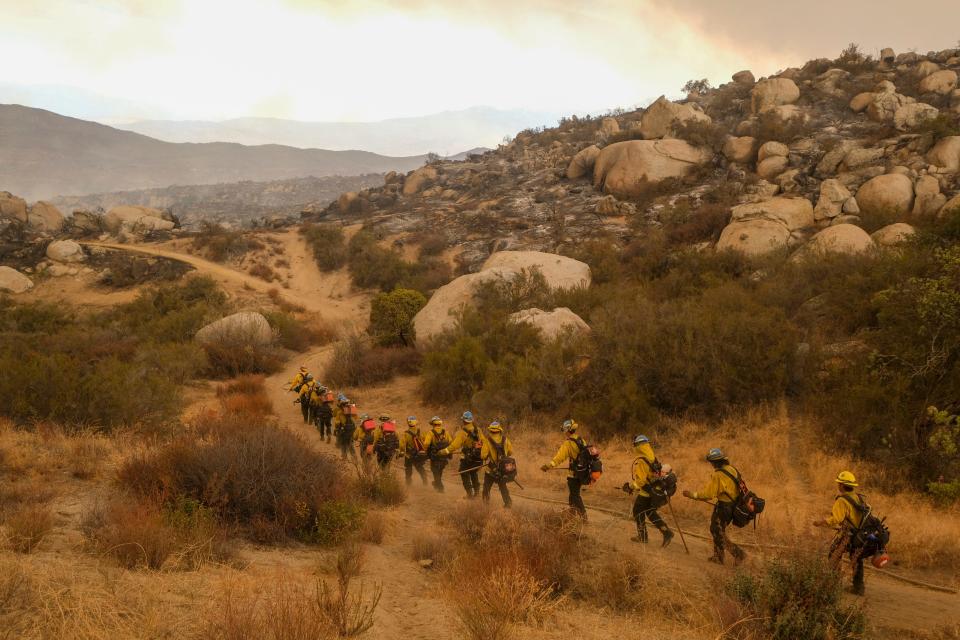EXCLUSIVE: Homes with high wildfire risk are selling for $178,000 more than low-risk homes
Homebuyers are paying a premium for homes that likely offer more space and access to the wilderness but could pose a wildfire threat within the same metro area, an exclusive Redfin analysis for USA TODAY has found.
Homes in a high wildfire-risk area sold for a median price of $566,513 compared with $388,488 for homes in a low wildfire risk within the same metro area – a premium of $178,025 – through August. The premium has increased 15% from 2021 when it was $155,0000.
Nationwide, homebuyers paid a 46% premium to live in homes with a high wildfire risk compared to homes with a low wildfire risk this year.
In fact, every year since 2017 – when they paid a 39% premium – homebuyers have steadily been paying more to live in areas with higher wildfire risk.
For instance, in Boise, Idaho, homebuyers paid 77% more or a $70,000 premium in 2022 to live in a high wildfire-risk area compared to 2017 when they shelled out $37,000 more.
In Tulsa, Oklahoma, the premium rose by 58%, from $32,364 in 2017 to $51,125 in 2022.
“People don’t seem to take into account the future risk,” says Sheharyar Bokhari, a senior economist for Redfin. “They haven’t internalized the risk yet. The premiums are driven by low interest rates we’ve had over the pandemic, seeking affordability wherever they can get, also the shift to work from home, where people just moved away looking for larger spaces.”
Of the 100 most populous metros that Redfin tracks, the only one with a negative dollar premium in 2022 was San Jose, California, where homebuyers paid $79,438 less for a home with a high fire risk.
“There are a lot of tech companies in the area, and people still value living close to their work rather than in the wilderness in the same metro area,” says Bokhari.
In Santa Clarita, seeking an 'experience'
When Jackie Wolf moved into a 3,000-square-foot home on top of a hill in Santa Clarita, California, with her young family in 2004, she says she knew the risk she was taking.
Her family was evacuated twice in 10 years under the threat of wildfire.
About 30 miles north of Los Angeles, the valley is categorized as very high risk for wildfire by the Office of the State Fire Marshall and in the last five years, the frequency and severity of the fires have only intensified. In 2019, the city had the largest evacuation in history, with 40,000 Santa Clarita residents fleeing the flames of the Tick Fire.
Although Wolfe, a real estate agent, has since sold her house and moved to the center of the valley after her kids left home, she says she’d do it all over again.
“We were looking for a large home with a pool and a view. And we could walk to the end of the street and there were hiking trails and motorcycle trails. There were no homes behind us, only hillside,” she says. “And so, we were willing to risk the fire danger for the living experience.”
During the pandemic, as people sought larger homes while their children attended school online and they had the option to work from home, the median sale price of a home in Santa Clarita went from $550,000 in January 2020 to $790,000 in July 2022.
“So in Santa Clarita, regardless of the fire risk, and the severe drought, people were still moving out here because the homes are large enough and they were paying the same for their mortgage in Santa Clarita as they would for their rent in LA,” says Wolf.

Dawn Marie Brown, a real estate agent in Sacramento, California, knows what’s it like to live under the constant threat of being evacuated. Many of her family members have been evacuated multiple times.
Her 76-year-old mother is constantly prepared, she says.

“She always has water in her car,” says Brown. “She has all of her important documents either in the refrigerator or in her vehicle.”
But Brown, who bought a home in the area five years ago, wouldn't dream of moving elsewhere.
"This is where I am from," she says.
Wildfires and the cost of insuring them
Wildfires in the United States are starting earlier, inflicting greater losses, occurring in more states, and taking more time to suppress, according to the Insurance Information Institute. As many as 90% of U.S. wildfires are caused by people, according to the U.S. Department of Interior. The remaining 10% are started by lightning or lava.
In 2020, there were 58,950 wildfires in the United States, compared with 50,477 in 2019, according to the National Interagency Fire Center. About 10.1 million acres were burned in 2020, compared with 4.7 million acres in 2019.
Insured losses from wildfires in the U.S. have exceeded $13 billion and economic losses have topped $20 billion in three of the last four years, according to Aon. Catastrophe losses related to wildfires at Farmers Insurance Group of Cos. touched $2.1 billion in 2018 alone.
Most wildfire losses that have hit the insurance market originated from California utility companies due to inverse condemnation, which states that private property owners are entitled to compensation if their property is damaged by the government or utilities, according to S&P Global.
The increased number and severity of wildfires increase in recent years led to a sharp rise in insurers’ decisions not to renew or write new homeowners insurance policies in California.

California wildfires and insurance 'non-renewals'
A 2019 report by the California Department of Insurance found the state saw a 31% increase in non-renewals in the private insurance market and a 203% jump in non-renewals for homes in the top 10 counties with the highest wildfire exposure.
Homeowners whose risk is too great to obtain coverage in the private market can buy coverage from the insurer of last resort, the California FAIR Plan, which has higher premiums and limits on coverage.
As the insurer-initiated non-renewals took hold, the FAIR Plan saw a 36% increase in policies statewide.
In response to the spike in non-renewals, California Insurance Commissioner Ricardo Lara instituted a one-year mandatory moratorium on insurance companies non-renewing policyholders in areas with a declaration of state of emergency. Following the moratorium, non-renewals fell 10% statewide in 2020 compared to the previous year.
Last month, Lara signed into law a new insurance pricing regulation that would require insurance companies to provide discounts to homeowners and businesses for undertaking wildfire safety and mitigation efforts.
Seren Taylor, senior legislative advocate for the Personal Insurance Federation of California, said while insurers support comprehensive mitigation standards, the mitigation discounts must be based on data that aligns the cost savings with the actual risk reduction.
Insurers should be allowed to use the most advanced technology to more accurately model California’s evolving climate risk, he says.
“The worst losses have been in the past five years but the regulations require you to look at the past 20 years and don't allow you to do is to look forward at what's coming,” Taylor told USA TODAY.
Paying a premium for a 'lifestyle'
Wolf says her clients are willing to pay a premium for a "lifestyle."
"If we look at a property that's up against a hillside with a beautiful backyard, lots of open space. Those are the properties that people were going for because they're, they're unique," she says. "Those homes on the outskirts are the ones that we're selling at a premium because they're private, they're surrounded by nature. Sometimes deer would come down to the backyards, things like that."
But Wolf says she's upfront with her clients on the risk of wildfire.
"I'm always very forthright with the fire risk because the cost of the fire insurance will severely impede their purchasing power when they buy," she says.
Their reaction?
"Generally, it's 'oh, thank you for letting us know, we will research that, but then they most likely will continue to write the offer," she says.
Swapna Venugopal Ramaswamy is a housing and economy correspondent for USA TODAY. You can follow her on Twitter @SwapnaVenugopal and sign up for our Daily Money newsletter here.
This article originally appeared on USA TODAY: Why are people paying more to live places with high wildfire risk?

 Yahoo Finance
Yahoo Finance 